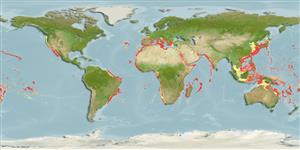Common names from other countries
Environment: milieu / climate zone / depth range / distribution range
Ecología
; rango de profundidad 50 - 850 m (Ref. 881). Tropical; 46°N - 23°S, 119°E - 56°E
Indo-Pacific, Atlantic Ocean and the Mediterranean: from Taiwan to New Caledonia, north to Italy and east to Reunion Island. Tropical and subtropical.
Length at first maturity / Tamaño / Peso / Age
Maturity: Lm 1.8 range ? - ? cm Max length : 3.4 cm CL macho / no sexado; (Ref. 106434); 4 cm CL (female)
Maximum depth from Ref. 97531. Maximum length based on occurrence (Ref. 106434); to be replaced with a better reference. Occurs in the continental shelf (Ref. 122888) and bathyal communities of the upper and middle slope (Refs. 113874, 102666), where it is dominant in the latter (Ref. 102666). Found in muddy and rocky bathyal substrates (Ref. 122889).
Life cycle and mating behavior
Madurez | Reproducción | Puesta | Huevos | Fecundidad | Larva
Members of the order Decapoda are mostly gonochoric. Mating behavior: Precopulatory courtship ritual is common (through olfactory and tactile cues); usually indirect sperm transfer.
Pinho, M.R., J.M. Gonçalves, H.R. Martins and G.M. Menezes. 2001. (Ref. 2747)
IUCN Red List Status (Ref. 130435)
CITES status (Ref. 108899)
Not Evaluated
Not Evaluated
Human uses
Pesquerías: comercial
| FishSource |
Herramientas
Fuentes de Internet
Estimates based on models
Preferred temperature
(Ref.
115969): 8.8 - 21.2, mean 14.2 (based on 536 cells).
Resiliencia
Alto, población duplicada en un tiempo mínimo inferior a 15 meses (K=0.65-0.84; tm=1.5).
